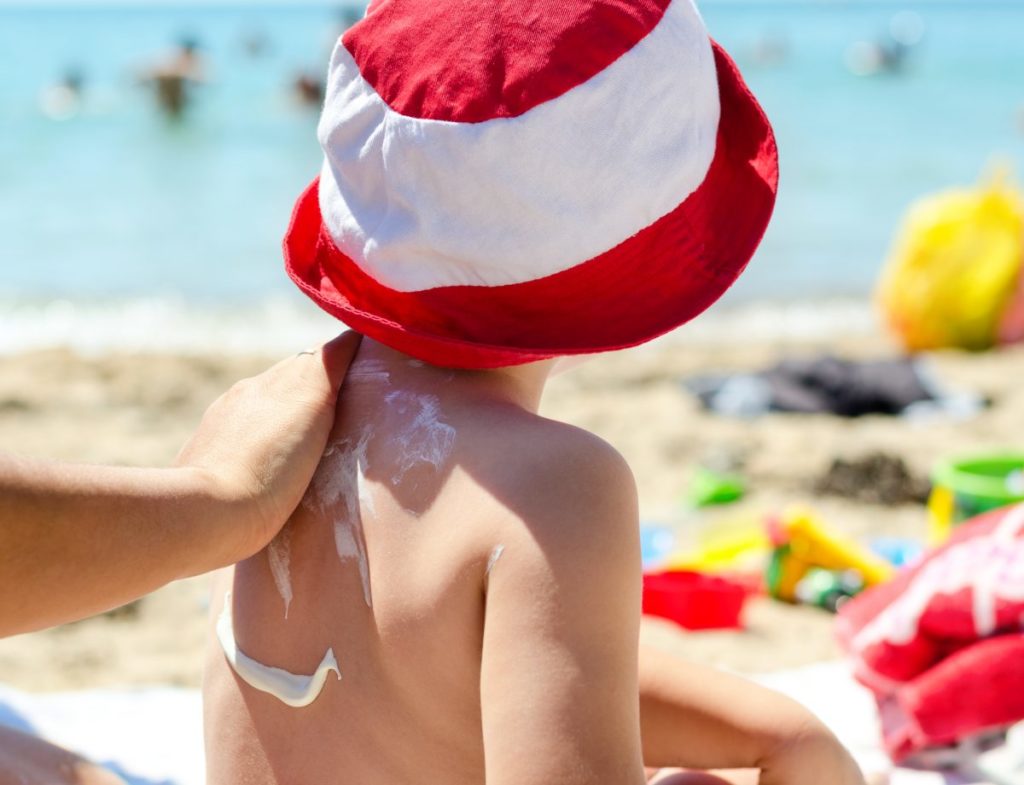According to the experts, it only takes 15 minutes outside in the sun for you to get a sunburn, depending on the UV Index value that day.
If the UV Index is higher than 3 you and your children definitely need sunscreen and if it is over 8 then you will need even more protection, including wearing hats, covering up more skin and only being out in the sun for short intervals.
Infants and young children are the ones most at risk. Check out these 6 tips on keeping your children safe from the sun this summer:
Cover Them Up
Protecting your kids’ skin should be your number one priority. When the sun is really oppressive, make sure you kids are wearing light, breathable t-shirts, wide brimmed hats to protect their face and sunglasses to protect their eyes. Remember that thin, light-colored and breathable clothing is the best thing to wear in the sun.
Limit Their Time in the Sun
Even if your children are covered in sunscreen and light clothing, too much sun exposure is still dangerous. The hottest part of the day is typically between 12 noon and 3 p.m. depending on where you live. So this is the perfect time to take the kids inside for a little bit of break. Naps, lunches and a little respite and then they can go back out when the sun is not as intense.
Use the UV Index Forecast as Your Guide
Experts also recommend that you use the UV Index forecast as a guide. Make sure you look it up every day before you go outside and follow its recommendations accordingly.
Make Sunscreen a Daily Habit
Starting from an early age, you should make it a daily habit that everyone wears sunscreen every time they step outdoors. When it becomes a daily routine, you will never forget to apply it again. If your older kids are applying it themselves then make sure they are paying attention to the areas of the body that are most exposed to the sun like the nose, lips, back of the neck, shoulders, arms, back, knees and feet.
Reapply Sunscreen Often
The most important thing to remember is that just applying sunscreen once is not enough. You need to keep reapplying every few hours. And make sure whatever sunscreen you use has a high SPF. Typically what is recommended is a SPF 15 or higher.
Practice Heat Illness Prevention
It is also important to realize that it is not just sunburn that you have to worry about. Heat illness can be even dangerous Too much heat exposure can lead to heat stroke, rashes, cramps, fainting, edema, exhaustion, even death.
Our bodies are truly a balancing act, because while drinking water can help us recovery from too much heat, too much water can also be bad for us too.
Here are some tips for heat illness prevention:
- Be prepared for the heat. Nothing is worse than spending the whole day outdoors and not being prepared for the heat. Listen to the weather forecast before going out for the day and also check the UV Index forecast like stated before. Make sure you always have cold water with you and make sure your home and work space are cooled off whether from fans or air conditioning. When you are going outside, take a little portable fan and stick to the shade as much as possible.
- Trips to your local library or mall are perfect for really hot days. Cool off for a few hours in the air conditioning while stocking up on some reading material or window shop at your favorite stores. Book stores are another great place to spend a few hours.
- Constantly monitor your children for symptoms of heat illness. If they are feeling dizzy, faint, nauseous or suffering from headaches these are all warning signs. Rapid breathing, extreme thirst, decreased urination and changes in behavior are also signs of concern. If you do notice these symptoms, immediately move your child to a cool place, and apply cool water to large areas of skin or clothing while also fanning them. AND this is really important, have them drink room temperature water not cold water. Cold water will worsen their symptoms.
- Keep your kids hydrated. Your children might not like drinking water, but it is essential for them to do so. Make sure they are drinking enough water and eating more fruits and vegetables before, during and after physical activities, especially outdoors.
What Should You Know About Melanoma in Kids
Melanoma is the most serious type of skin cancer and its most common cause is too much exposure to ultraviolet (IV) radiation from the sun’s ray. Did you know that melanoma is the most common skin cancer in children? About 7 percent of cancers in children 15 to 19 years of are melanoma. It is most common in Caucasian people.
The good news is that with melanoma most cases are diagnosed early enough so that just the top layer of skin is affected. Here is what to be on the lookout for:
With melanoma, any moles your child has may change in size, shape, color, even feel of the mole. Dermatologists usually use the “ABCDE test to diagnose melanoma:
- Asymmetry – the shape of one half of the mole is different from the other half.
- Border – the edges are ragged, blurred, irregular
- Color – uneven and including shades of black, blue-black, brown or tan.
- Diameter – changes in the size of the mole, usually an increase in size.
- Evolving – changes in the mole over a few weeks or months
Childhood melanoma is a little trickier though. This what you should look for if you are worried about changes to your child’s skin:
- A mole that changes or grows
- An odd-shaped or large mole
- A mole or bump that itches or bleeds.
For more information, visit the American Cancer Society website. Make sure keeping your children safe from the sun is a priority this summer.



